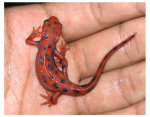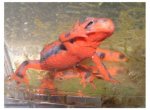While I was posting, I thought I'd post these photos that I ran across. I'll attach the photos, but also include a link to a blog post about them from the animal dealer who had them. I'm not going to speculate about the reputability of the dealer, but the photos were very interesting to me:
http://peponi.exblog.jp/6026107/
Perhaps someone who can translate properly can add more context.
I had never seen anything like them before, and the only thing that I ran across that reminded me of them was an "illustration" of a C. wolterstorffi from livingunderworld.org on their cynops page:
http://www.livingunderworld.org/cau...orffi/cynops_wolterstorffi_illustration_2.gif
I haven't seen any other Cynops (which I assume that animal is) with red coloration on their backs as well as bellies. That doesn't mean there aren't mutations out there that might cause this in common species though...
Anyways, I just thought I'd share my curiosity. I won't be finding a bigfoot carcass in my backyard anytime soon, but it would be interesting if this was indeed a specimen thought to be extinct.
Any thoughts?
Thanks,
-Neel
http://peponi.exblog.jp/6026107/
Perhaps someone who can translate properly can add more context.
I had never seen anything like them before, and the only thing that I ran across that reminded me of them was an "illustration" of a C. wolterstorffi from livingunderworld.org on their cynops page:
http://www.livingunderworld.org/cau...orffi/cynops_wolterstorffi_illustration_2.gif
I haven't seen any other Cynops (which I assume that animal is) with red coloration on their backs as well as bellies. That doesn't mean there aren't mutations out there that might cause this in common species though...
Anyways, I just thought I'd share my curiosity. I won't be finding a bigfoot carcass in my backyard anytime soon, but it would be interesting if this was indeed a specimen thought to be extinct.
Any thoughts?
Thanks,
-Neel






